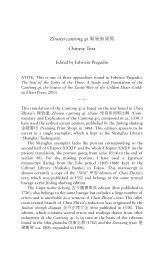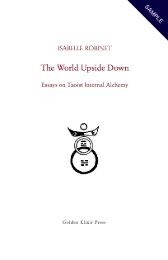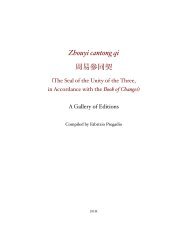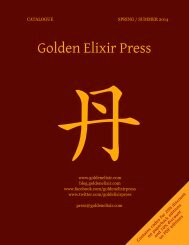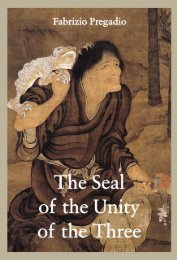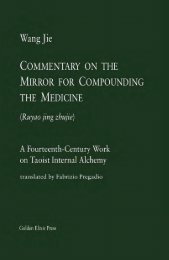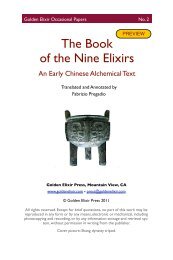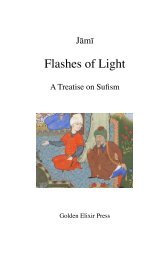The Seal of the Unity of the Three â Vol. 2 - The Golden Elixir
The Seal of the Unity of the Three â Vol. 2 - The Golden Elixir
The Seal of the Unity of the Three â Vol. 2 - The Golden Elixir
- No tags were found...
Create successful ePaper yourself
Turn your PDF publications into a flip-book with our unique Google optimized e-Paper software.
Introduction 9<br />
—————————————————————————————————————————<br />
notes that quote comparable passages from Western alchemical<br />
literature. <strong>The</strong> translators understood and explicated <strong>the</strong> Cantong qi<br />
as an alchemical text concerned with Waidan (External Alchemy).<br />
<strong>The</strong> English version by <strong>the</strong> above-mentioned Zhou Shiyi, entitled<br />
<strong>The</strong> Kinship <strong>of</strong> <strong>the</strong> <strong>Three</strong> (1988), is based on Wu’s and Davis’ work. It<br />
improves its source in many ways, but frequently makes recourse to<br />
extended paraphrases in order to represent <strong>the</strong> text as exclusively<br />
concerned with Neidan. 10 Zhou’s work is based on Peng Xiao’s<br />
redaction, and includes a Chinese-English glossary <strong>of</strong> technical terms.<br />
Richard Bertschinger’s rendering <strong>of</strong> <strong>the</strong> so-called “Ancient<br />
Text” (“Guwen”) <strong>of</strong> <strong>the</strong> Cantong qi, published as <strong>The</strong> Secret <strong>of</strong><br />
Everlasting Life (1994), is a remarkable achievement, although it <strong>of</strong>ten<br />
departs from <strong>the</strong> original Chinese in order to translate <strong>the</strong> text into<br />
rhyming poetry. Bertschinger includes notes translated or summarized<br />
from <strong>the</strong> above-mentioned “Zhouyi cantong qi jiangjie” by Fang Xu,<br />
and selections from <strong>the</strong> commentaries by Zhu Xi, Yu Yan, and Chen<br />
Zhixu. 11<br />
<strong>The</strong> Cantong qi was also translated and annotated into Japanese<br />
by Suzuki Yoshijirō 鈴 木 由 次 郎 , <strong>the</strong> eminent Japanese scholar <strong>of</strong> <strong>the</strong><br />
Book <strong>of</strong> Changes. His work, entitled Shūeki sandōkei 周 易 參 同 契<br />
(Zhouyi cantong qi, 1977), is one <strong>of</strong> <strong>the</strong> finest contributions to <strong>the</strong><br />
study <strong>of</strong> <strong>the</strong> Cantong qi. Based on an undated Korean edition <strong>of</strong> Yu<br />
Yan’s redaction, and influenced to some degree by Yu Yan’s commentary,<br />
it includes <strong>the</strong> original Chinese text, a Japanese literal<br />
translation, annotations on terms and verses, collation notes, and<br />
excellent explications <strong>of</strong> each section. 12<br />
10<br />
To give one example, verses 1:5–6 (which may be translated quite literally<br />
as “Female and male, <strong>the</strong>se four trigrams / function as a bellows and its<br />
nozzles” 牝 牡 四 卦 、 以 為 橐 籥 ) are rendered as: “<strong>The</strong> microcosm <strong>of</strong> man’s<br />
body might be likened to <strong>the</strong> Chinese double-acting piston bellows. <strong>The</strong> o<strong>the</strong>r<br />
four trigrams, male and female, symbolise <strong>the</strong> cylinder <strong>of</strong> <strong>the</strong> bellows with<br />
Qian and Kun as its two valves” (p. 7).<br />
11<br />
Bertschinger’s translation is based on Ma Yizhen’s 馬 一 貞 Chongjiao<br />
Guwen cantong qi 重 校 古 文 參 同 契 (1840), which is a reedition <strong>of</strong> Yao<br />
Ruxun’s 姚 汝 循 Guwen cantong qi 古 文 參 同 契 (first published ca. 1575,<br />
and republished in 1820). Yao Ruxun, followed by Ma Yizhen, rearranges<br />
parts <strong>of</strong> Chen Zhixu’s commentary according to <strong>the</strong> ordering <strong>of</strong> <strong>the</strong><br />
“Guwen” version <strong>of</strong> <strong>the</strong> Cantong qi. I am grateful to Mr Bertschinger for<br />
providing me with details about his work and <strong>the</strong> edition he translated.<br />
12<br />
Suzuki’s work was posthumously published in 1977. <strong>The</strong> unfinished<br />
Visit <strong>the</strong> Web page on this book • www.goldenelixir.com



